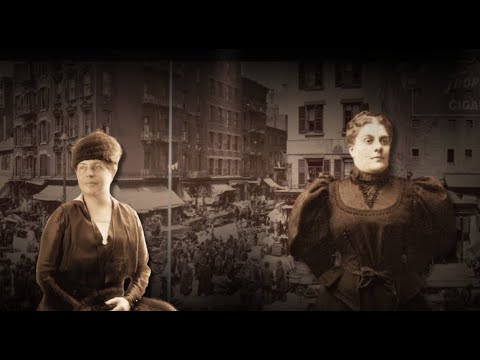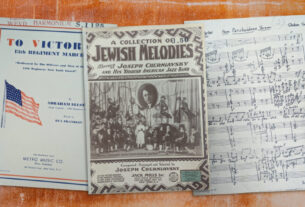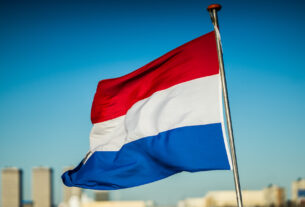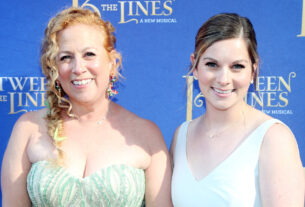(New York Jewish Week) — The Museum at Eldridge Street (probably) isn’t haunted, but ghosts were what artist Adrienne Ottenberg had in mind when she created the works now on view in the new exhibit at the 1887 landmarked synagogue, “On the Lower East Side: 28 Remarkable Women…and One Scoundrel.”
“When I first came to Eldridge Street, it was falling apart,” Ottenberg recalled of her first visit to the historic building in the 1990s, prior to the 20-year, $20 million restoration completed in 2007. “And it’s magnificent. It’s magnificent even when it’s falling apart. And I thought, oh my god, it’s haunted.”
Now, some of these neighborhood “ghosts” are getting a second life, courtesy of Ottenberg’s mixed-media works of art, which are on display at the museum through May 5, 2024. The exhibit features portraits of 29 notable women, born between the mid-1800s and early 1900s, who lived or worked in the Lower East Side or frequented the teeming immigrant neighborhood— including well-known Jewish figures like poet Emma Lazarus and activist Emma Goldman.
But the exhibit also showcases less famous neighborhood women, like Dora Welfowitz, a garment worker and union member who perished in the 1911 Triangle Shirtwaist Factory fire, and Belle Moskowitz, a social worker turned political advisor to Gov. Al Smith. So little is known about one of the subjects that she is identified simply as “Anonymous Chinese Actor,” highlighted here for her participation in a benefit for Jewish victims of a 1903 pogrom in Kishinev.
Researching and creating these portraits was “a gift,” Ottenberg told the New York Jewish Week, explaining that it gave her the opportunity to reconnect with her Judaism and delve into her own family history. Ottenberg’s father was Jewish (a Freudian analyst, to boot, making him a “certain kind of Jew,” she joked) and her mother was not; all told her parents “really didn’t have much interest in bringing us up in Judaism,” she said.
These days, however, Ottenberg, who lives in Chelsea, is married to someone who is “deeply religious” and attends synagogue every Saturday, though she noted that neither he nor his family ever put pressure on her to meet a certain level of observance. “We do all the holidays,” Ottenberg said, later adding, “All the positive things were there for me in Judaism. The warmth, the family, the celebrations…I feel so lucky in that.”
In “28 Women…,” Ottenberg’s portraits are printed on silk and cotton banners and depict the women against or interspersed with street maps of the Lower East Side. “I always start with maps,” Ottenberg, a cartographer by trade, said. “I believe a map can reveal something. A map is about connections, physical connections, but it’s also about other connections as well: emotional connections, connections through time.”
Unfortunately, time is what many of these women’s stories have been lost to — and that fleeting nature of existence is something Ottenberg considered when selecting the medium for her creations. “I wanted that quality of etherealness and the ephemeral quality, which fabric does,” she said. “If you have something on paper, behind a frame, it doesn’t feel ephemeral. But fabric, when you walk past it and it floats in the air, you can sense the transience of, hopefully not just their lives, which are gone, but our lives as well.”
The idea for the exhibit originated in the fall of 2022, after the museum’s curator and archivist, Nancy Johnson had a discussion with Ottenberg about showing her work. As Ottenberg spent time in the synagogue, the idea of spotlighting lesser-known local women took shape, with the early process informed by a friend of Johnson’s who has “made it a personal passion to find out about women from this neighborhood,” Johnson said.
Ottenberg, according to Johnson, “did a lot of reading and talking and walking.” Both conducted research, with Ottenberg citing the Library of Congress, Google Scholar and the New York Public Library as invaluable to her process.
Ultimately, “the selection process really was who moved me, and who I felt had impact, big and small,” Ottenberg said. She also wanted to ensure that a wide breadth of women were included, such as Helen Tamaris, who used dance to speak to the country’s racial injustice, and Elizabeth Tyler, one of the first Black registered nurses and the first Black visiting nurse at The Henry Street Settlement.
“When we have these temporary shows, I always like to do something that kind of resonates in this space, that has to do with the stories that we tell here and the people who pass through this building and this neighborhood, so this did that big-time,” Johnson told the New York Jewish Week. Ottenberg “really looked for connections to this neighborhood, and it turns out that it was a place where a lot of activist women were, either worked here, or lived here, or passed through here, or were inspired by things that happened here.”
Support the New York Jewish Week
Our nonprofit newsroom depends on readers like you. Make a donation now to support independent Jewish journalism in New York.
For each portrait, there is a corresponding story of the woman’s life available to hear for free via the Bloomberg Connects app. Written by Johnson, the stories are told in the first-person, and recited mostly by the museum’s docents, former staff or those with personal connections to the subjects. (The story of Mirele Poil, a Jewish garment worker who successfully organized a walkout in her workplace, leading to a union contract, is voiced by her great-granddaughter, Diane Shur.)
Some of the women featured in the exhibit played a critical role in creating the world we know today — and until recently, were unknown to Ottenberg and much of the rest of the world. Take Fania Mindell, who co-founded the Brownsville Clinic with family planning pioneers Margaret Sanger and Ethel Byrne and was responsible for translating materials on birth control into languages like Yiddish and Italian. Ottenberg was “delighted” to learn about Cora La Redd, a Black dancer and singer who lived on Broome Street and performed regularly at the Cotton Club.
Ottenberg said the show is the culmination of a year of work, over which time she “fell in love with these women.” And she’s not the only one: As a reporter toured the exhibit on opening day, a museum-goer thanked Ottenberg, saying, “It was so nice to meet Emma Goldman again. I hadn’t thought about her in a while.”
“Don’t you love her?” Ottenberg asked — and the visitor confirmed she did.
Even the “scoundrel” of the exhibit found her way into Ottenberg’s heart. “I could not resist Stiff Rivka,” Ottenberg said of a notorious pickpocket who flew under the radar by camouflaging herself as a rich woman, dressed to the nines for Shabbat.
“It wasn’t just all these amazing women, doing these incredible things — there were people doing really questionable stuff,” Ottenberg said.
Though 21 of the women in the exhibit are Jews, a wide variety of ethnicities are represented in order to honor the truly multicultural history of the Lower East Side. “The unintended consequences of this 19th-century neighborhood mix of cultures and languages and poverty and reinvention was a Lower East Side that let loose new American ideas about education, equality and justice,” Ottenberg said in a press release. “It was a place women could step into a larger role for the people around them, and they did not ask permission to do it.”




